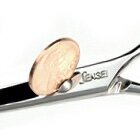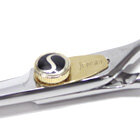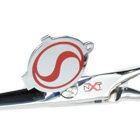FAQ
Q. What does “ergonomic” mean?
A. Product design that maximizes productivity and minimizes fatigue and discomfort. Human engineering.
Q. What length shear should I buy?
A. The longest length you’re comfortable with. In cutting between your fingers, you will only use the first inch of the shear regardless of it’s length. However, in “free” cutting, shear over comb, and cutting a bob line, you can make use of the added length to save time and get straighter lines.
Q. How do I care for my shears?
A. Wipe off the blades after every haircut. Close them completely before setting them down or putting them away. Always keep them in their case. Oil them daily - yes, daily, it helps keep dirt.hair and product from building up in the shear and it will protect the pivot area against corrosion.
Q. How do I oil my shears?
A. Make an “X” shape with your shears, slide a drop of oil between the blades from both directions. Open and close your shears with your normal cutting action for 20 or 30 seconds, you’ll see dirt and hair float out of the pivot area. Wipe dirt and hair and any excess oil from the shears leaving a light film of oil in the pivot area to prevent corrosion.
Q. How do I adjust my shears?
A. After oiling, slowly open and close the shears with your normal cutting action, you should feel the blades touch at the back and touch evenly to the tip. If you shears are too loose, they will not touch at the back and may fall open when you palm them or fold hair instead of cutting it. To tighten a shear with an adjustable screw, use a coin or a screwdriver in the screw slot, turning it as you would the hands of a clock (righty-tighty, lefty loosey). Turn the screw ahead the distance of “5 minutes” as on the face of the clock, check tension and repeat if necessary.
If your shears have an internal locking adjuster, use the key to turn the adjuster clockwise. The adjuster will click as it turns. Turn the adjuster one or two clicks, check the tension and repeat if necessary.
If your shears have a locking adjuster dial, simply turn the dial clockwise to tighten counter-clockwise to loosen.
Q. What if my shears won’t cut tissue paper?
A. Don’t worry about it. the “tissue paper” test is often misused and misleading. We can show you thousand dollar shears that cut hair perfectly but don’t cut tissue paper.
Q. I’m left handed, should I buy left handed shears?
A. If you’re a lefty and you’re cutting with right-handed shears , your tendency, whether you are aware of it or not is to “pull” with your thumb in order to force the blades together. This is the reason right-handed shears cause greater fatigue in lefties. You can cure this with a left handed shear however, some retraining is required. If you “pull” with your thumb in a left-handed shear, you will force the blades apart, creating the same problem you had when you began with a right-handed shear. In order to retrain, practice opening and closing the hand naturally without pulling. You can make this easier by using a shear with a locking adjuster and increasing the tension to take the place of the tension you were artificially adding by “pulling” with your thumb. You can also put finger inserts in the thumb piece to prevent the thumb from extending all the way through the shear and pulling. Remember,: Relax the hand and let the adjuster do the work.
Q.What’s the difference between a thinning shear and a texturizing shear?
A. “Thinning” shears take out fine amounts of hair in even amounts. Their purpose is to blend lines and remove bulk subtly. “Texturizing” shears take out hair in larger sections creating more noticeable movement, lift, and bulk reduction. “No Line” texturizing shears take out hair in totally random patterns just the way you would with the tips of your shears.
Q. What if my texturizing shear doesn’t have an ergonomic handle?
A. It’s not a big deal. Mnay texturizing shears are made with opposing handles so they can be used with the teeth facing either direction. And you’re only using them for a few minutes during the cut.
Q. Where did my shears come from?
A. Your shears will tell you. Manufacturers shipping to the U.S. are required by law to mark their products with a country of origin. Unfortunately, some don’t. If your shears don’t have a country of origin marked on them, chance are they came from China, Taiwan or Pakistan. We only sell shears marked with a country of origin.
Q. What should my shears be made of?
A. Stainless steel, hard stainless steel. We don’t mean to be funny, but a goal in making shears is to make them hard enough to hold an edge but not so hard as to make them brittle. This takes into account whether the shear is cast or forged, whether a metal such as cobalt or molybdenum is added, and how the shear is tempered. Without going into pages of detail, we only offer shears in a hardness range that makes them most durable.
Q. How do I troubleshoot my shears?
A. Sometimes you can quickly solve shear problems yourself or provide a temporary solution until your shears can be professionally repaired. Sometimes you can’t. Click here to find out how you can tell.
Q. What about special orders?
A. We can special order almost any shear available, please contact us.




